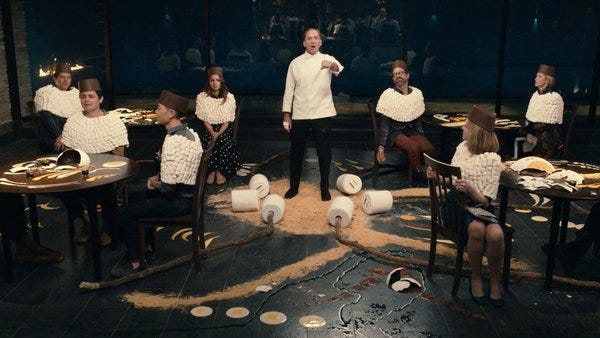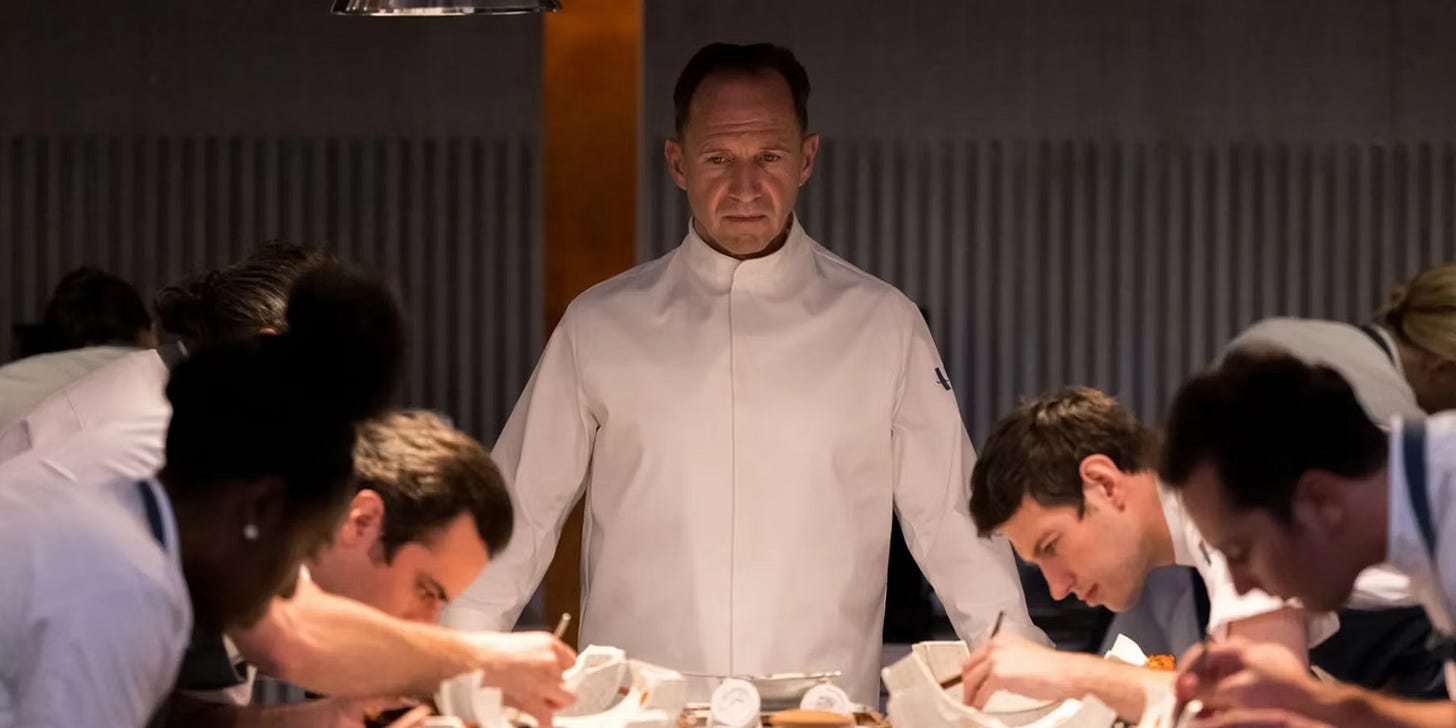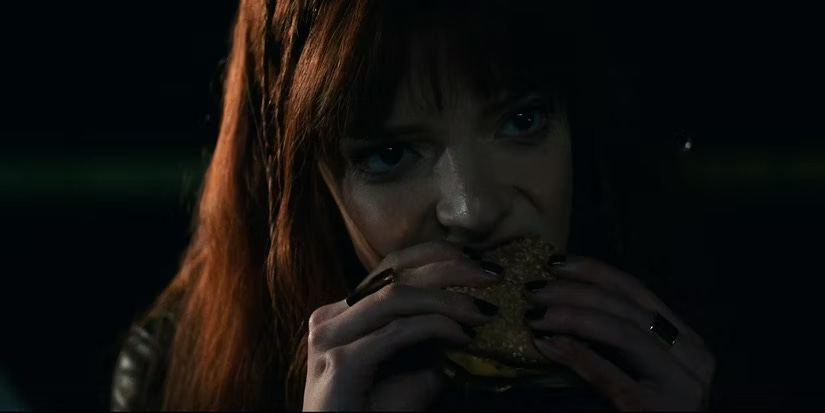<Disclaimer: This review contains Major Spoilers for The Menu (2022)>
When I first heard about Searchlight Pictures’ The Menu I thought, ‘Oh cool, a film about the horrors of consumerism paralleled through cannibalism. Neat.’
On finally watching the film, however, I was confused. ‘Wait,’ I thought. ‘Where’s the cannibalism?’
While I was not the only one to be confused about the premise of food-based horror leading to cannibalism, the cannibalism in The Menu is a symbolic one; showcasing how losing sight of one’s passions can turn into twisted ambitions that consume you from the inside out.
The Menu, released in 2022, directed by Mark Mylod, stars Anya Taylor-Joy, Ralph Fiennes, and Nicholas Hoult among a star-studded ensemble cast. The comedy-horror follows fanboy foodie Tyler (Hoult) and his date Margot( Taylor-Joy) as they travel to the exclusive island restaurant of celebrity chef Slowik (Fiennes), who has prepared an elaborate menu of lavishly extreme dishes.
The cannibalistic consumerism of The Menu can be seen throughout in the examination of the patrons that frequent the restaurant. Each one harbors their own scheme of subterfuge to exacerbate Chef Slowik’s conspiracy, all in the name of personal power and greater wealth. These ploys range from money laundering to infidelity, to theft, and overt criticism- all sins that have contributed to the siphoning of Slowik’s soul and for which he resolves to seek retribution.
Through the use of nigh insufferable pretentiously titled dishes such as ‘Man’s Folly’ and ‘Breadless Bread Plate,’ the titled Chef reveals macabre twist after twist, citing each of his guests’ crimes as his reasoning for their fates.

Not even the staff of Slowik’s restaurant are impervious to their own hubris. Such staff includes:
Elsa (chillingly played by Hong Chau), Slowik’s right hand and maître d’, has a supercilious drive for violence, attacking Margot without provocation.
Jeremy, a sous chef who shoots himself during the fourth course, appropriately titled ‘The Mess.’ He precedes his self-execution with a morbid speech decrying his own efforts to reach Chef Slowik’s culinary caliber; a fruitless endeavor, according to both chefs.
Katherine (Christina Brucato), a sous chef who was sexually harassed multiple times by Chef Slowik and later stabs him as part of a revenge ploy of her own design; she reveals to the terrified guests that she is the true mastermind behind the idea to kill them all as part of ‘the menu’ for the evening.
Though no one perhaps is as unforgivable as the foodie, Tyler, whose single-minded self-serving goal to meet Chef Slowik comes at the expense of not just his own life, but of Margot’s.
It speaks to the deep rooted and often token overlap of misogyny and expectations of service work how Margot existed only for consumption; something to be used and discarded after purpose served. Even given prior knowledge of what awaited for them, Tyler still took her to the island restaurant, so great was his conceit and lack of concern for another life other than his own.
But like a mockery of Icarus too close to the sun, Tyler’s ambition comes back to bite him. Overhearing his pretentious commentary on the meals, Slowik extends an invitation for Tyler to cook a meal. What ensues doesn’t even feel satisfying to watch: his floundering is cringe-worthy to the extreme, secondhand embarrassment at its finest. His resulting dish is pathetic- he is pathetic- solidified in Chef’s final whispered deliberation for him, and Margot finds him later having hung himself in a closet.
Throughout the various courses of the night, Margot is the only one who sees straight through the ostentatious pageantry and isn’t duped by it. When she’s told by Slowik to go and fetch a barrel for the final dish, she sneaks into his main house and uncovers a framed Employee of the Month photo of a joyous young Slowik as a fry cook at a diner. She is confronted and attacked by Elsa, who is furious by Margot’s unexpected presence on the island, and the way she has captured Slowik’s attention. Upon fatally stabbing the maître d’, Margot makes her bloody return back to the restaurant proper and continues to further flip the script.
She stands and Claps, demanding the attention of everyone in the room in the same exact way that Chef Slowik had been doing the whole night. She then proceeds to denounce him and his food as hypocritical, saying that she doesn’t like his food and wants to send it back. The patrons look on in horrified fascination as she demands satisfaction, saying that all of Chef’s food is tasteless and lacking in love, and- the worst of all- despite dining all night she is “still f-cking hungry.”
Bemused at first, Slowik seems to turn a touch desperate at those words and asks her what she would like to eat. He has a reputation to uphold, after all, even in this blackest night, and he can’t leave any guest truly unsatisfied.
And Margot lifts her chin and requests…a cheeseburger.
The Cheeseburger is more than a ‘supplemental course,’ it’s a symbol: of passion, of love, of art…and of humanity.
Slowik, in all his infinite achievements and prestige has lost his humanity. He has been stripped of it, eaten alive by the industry of those who devoured his love for cooking as he serviced them over the years. He became nothing more than [Chef], a figurehead to be placed on an inhuman pedestal.
But in this moment, Margot robs him of that- with her Clap, she takes away his authority; peeling away his hubris and giving him back his humanity, if only for a moment.
She saw him- past the prestige and the pretension she saw him the fry cook, and reminded him of his passion and true love for food. She reminds him that he’s human, not [Chef], not a machine- something that many a patron forgets when dealing with service workers. By seeing him as human, it allows him to do the same for her. She is no longer a consumer, a ‘taker’; she is not another cannibal to eat away at his soul like all the others.
It is this connection, this true seeing of him that ultimately allows her to ask ‘Can I get this to go?’- and which leads him to agree to let her.
The other patrons, too, realize this and are not bitter over her escape to safety. They have sealed their own fates, but they realize that there is still hope for her…and through her, hope for humanity.
While the island paradise goes up in flames, Margot enjoys the remains of her cheeseburger aboard a rickety Coast Guard boat, using the restaurant’s menu as a napkin- as if to solidify its only fitting use.
The Menu is a bizarre yet thrilling feature, and one whose message I am sure will be savored for quite a while.







